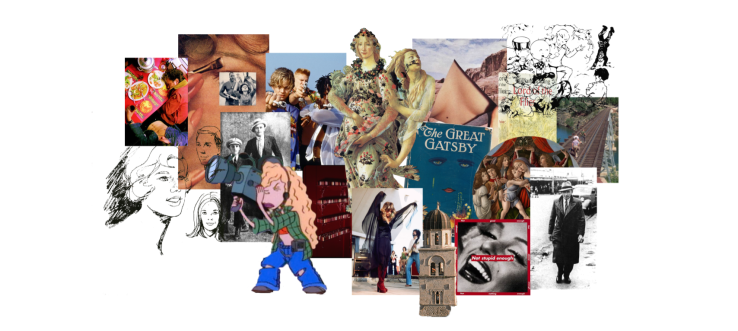
TIMELINE ASSIGNMENT
STORYWORLDS
3 CONTEXTS
- HERITAGE (CROATIAN HISTORY)
- SOCIAL CULTURE (HISTORY OF FILM)
- INSPIRATION (RENAISSANCE, FEMINIST ART)
INSPIRATION
ITALIAN RENAISSANCE / FEMINIST ART
Referenced in Visual
- ‘La Primavera’ Sandro Botticelli 1470
- ‘Madonna and Child with Six Angels’ Sandro Botticelli 1500
- ‘Untitled (Not Stupid Enough)’ Barbara Kruger 1997
- ‘Lipstick Bathroom’ Camille Grey 1973 (Part of WomanHouse Exhibition)
HISTORY OF ITALIAN RENAISSANCE ART (1300-1600)
14th Century – Trecento
1267 Birth of Giotto
1348 Black Death spreads through Europe, 25-50% of the population are infected
1386 Birth of Donatello
1389 Birth of Cosimo de Medici, the first of the Medici political dynasty in Florence
15th Century – Quattrocento
1401 Birth of Massacio
1420-36 Brunelleschi creates the Dome of Florence Cathedral
1428 Death of Massacio
1431 Birth of Mantegna and Bellini
1446 Birth of Botticelli
1449 Birth of Lorenzo de Medici, Cosimo’s son and later, a sponsor of Botticelli and Michaelangelo
1450 Donatello creates his sculpture David
1452 Birth of Leonardo da Vinci
1466 Death of Donatello
1469 Lorenzo de Medici takes power in Florence
1475 Birth of Michaelangelo
1483 The opening of the Sistine Chapel
1488 Death of Verocchio, Botticelli paints The Birth of Venus
1490 Birth of Titian
1488 Michaelangelo is apprenticed to Ghirlandaio
1495 Leonardo paints The Last Supper
16th Century – Cinquecento
1505 Leonardo paints the Mona Lisa
1506 Death of Mantegna
1508 Michaelangelo begins working on the Sistine Chapel
1510 Death of Botticelli, Raphael paints School of Athens, Michaelangelo paints Creation of Adam
1518 Leonardo paints his portrait of Leo X
1519 Death of Leonardo da Vinci
1520 Death of Raphael
1564 Death of Michaelangelo
1576 Death of Titian
HISTORY OF THE FEMINIST ART MOVEMENT (1960-1990)
1960 Feminist Art Movement begins
1964 Yoko Ono’s Cut Piece challenges violence against and the sexualisation of women
1970 Prominent feminist artists Judy Chicago begins her education of women in the art industry with the opening of her art school
1971 Why Have There Been No Great Women Artists? an essay by Linda Nochlin, was published in ARTnews, a publication formerly showcasing essays from only a male POV
1972 The A.I.R studio is founded, the first of its kind to showcase solely art made by women, Judy Chicago’s Womanhouse exhibition is debuted to the public, combining works from over 20 female artists, each inhabiting a room of a house with their art. 10’000 visitors arrive to see the exhibition
1973 Feminist Studio Workshop is created by Judy Chicago, Arlene Raven and Sheila Levrant de Bretteville in LA
1979 Judy Chicago debuts Dinner Party, widely known as the first ‘epic’ feminist art, she aimed to give women ‘a seat at the table’ by creating a table showcasing 999 prominent female figures of history
1985 The Guerrilla Girls are formed, a group of anonymous woman artists who performed out-of-box exhibitions and demonstrations to protest the patriarchy within the art world
1989 The Advantages of Being a Woman Artist was posted by the Guerrilla girls, a sarcastic and satirical list of all the ‘good’ reasons to be a female artist, challenging the idea that a far larger percentage of works in galleries are made by men
BIBLIOGRAPHY
HISTORY OF RENAISSANCE ART
Art History Timeline. (n.d.). Retrieved November 18, 2017, from http://www.dummies.com/education/art-appreciation/art-history-timeline/
Early Italian Renaissance the history of artistic achievement. (n.d.). Retrieved November 18, 2017, from https://www.italian-renaissance-art.com/Italian-renaissance.html
Early Renaissance Art (Italy) (1400-1490). (n.d.). Retrieved November 18, 2017, from http://www.visual-arts-cork.com/history-of-art/early-renaissance.htm
Early Renaissance Art (Italy) (1400-1490). (n.d.). Retrieved November 18, 2017, from http://www.visual-arts-cork.com/history-of-art/early-renaissance.htm
History.com Staff. (2010). Renaissance Art. Retrieved November 18, 2017, from http://www.history.com/topics/renaissance-art
Renaissance Timeline. (n.d.). Retrieved November 18, 2017, from https://www.italian-renaissance-art.com/Renaissance-Timeline.html
Italian Renaissance Art (1400–1600). (2016, January 16). Retrieved November 18, 2017, from http://arthistoryteachingresources.org/lessons/italian-renaissance-art-1400-1600/
HISTORY OF FEMINIST ART
The Feminist Art Movement timeline. (n.d.). Retrieved November 18, 2017, from https://www.timetoast.com/timelines/the-feminist-art-movement
Feminism & Art. (2016, December 22). Retrieved November 18, 2017, from http://arthistoryteachingresources.org/lessons/feminism-art/
Feminism & Feminist Art. (n.d.). Retrieved November 18, 2017, from http://www.arthistoryarchive.com/arthistory/feminist/
Feminist Art Movement, Artists and Major Works. (n.d.). Retrieved November 18, 2017, from http://www.theartstory.org/movement-feminist-art.htm
T. (n.d.). Feminist art – Art Term. Retrieved November 18, 2017, from http://www.tate.org.uk/art/art-terms/f/feminist-art
